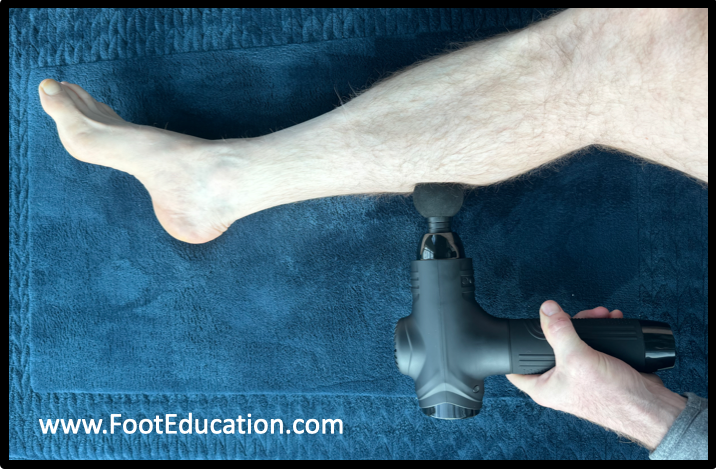Percussion Therapy for Muscles and Soft-Tissues of the Foot and Ankle
What is Percussion Therapy?
Percussion therapy is the rapid repetitive impacting of muscles and soft tissues using a percussion therapy gun, often called a massage gun (Figure 1). There is evidence to suggest that if used appropriately percussion therapy can increase muscle strength, increase muscle flexibility, and decrease muscle pain — especially pain related to delayed onset muscle soreness (DOMS).

Percussion Therapy as a Form of Soft-tissue Mobilization
Percussion therapy is a form of generalized soft tissue mobilization. Other forms of soft tissue mobilization include manual therapy, mechanical vibration, the use of a foam roller, and myofacial release techniques. All of these techniques manipulate muscles and soft tissues in various ways. Percussion therapy provides direct rapid compression of local soft tissues. It is also believed that it sets up a wave or oscillation of the impacted muscle fibers.
How Percussion Therapy Effects Muscles and Soft-Tissues
It has been proposed that percussion therapy has a positive effect via a number of different mechanisms. Creating oscillation of the impacted muscle fibers is believed to lead to relaxation of these muscle fibers with a resulting increase in their length. This would explain why studies have shown that percussive therapy using a massage gun on the calf muscles produces a noticeable short-term increase in ankle range of motion. It is also thought that percussion of muscle fibers and soft tissue would stimulate sensory receptors which may serve to decrease pain in that area. In addition, percussive therapy of muscles is believed to increase local blood flow which would increase soft-tissue oxygen saturation and help carry away the byproducts of muscle breakdown.
How to use a Massage Gun
Using a massage gun to provide percussive massage therapy to select muscle groups can help improve muscle pliability and decrease soft-tissue discomfort. If used appropriately prior to a workout or a competition a massage gun may improve muscle flexibility and performance. This type of therapy may also help improve recovery and decrease delayed onset muscle soreness (DOMS) following a workout. Typically, the massage gun is applied to a specific muscle for a short period of time, often 20–30 seconds, and no more than two minutes. This can then be repeated, although it is important to give the muscles a break. When beginning to use percussive therapy it is best to start with short sessions. Excessive use of a massage gun can create local bruising, pain, and decrease performance.
As a general guideline, percussive therapy should be applied to muscles. It should not be applied to bones, joints, or sensitive areas. When use appropriately may be a helpful, adjunctive treatment to mobilize soft tissue and improve muscle performance and recovery.
March 6th, 2024